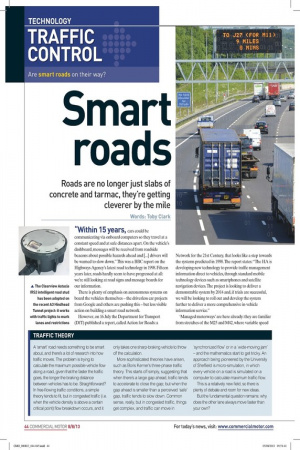Smart
Page 37

Page 38

If you've noticed an error in this article please click here to report it so we can fix it.
roads
Roads are no longer just slabs of concrete and tarmac, they're getting cleverer by the mile 'Within 15 years, cars could be
communicating via onboard computers so they travel at a constant speed and at safe distances apart. On the vehicle's dashboard, messages will be received from roadside beacons about possible hazards ahead and [...] drivers will be warned to slow down." This was a BBC report on the Highways Agency's latest road technology in 1998. Fifteen years later, roads hardly seem to have progressed at all: we're still looking at road signs and message boards for our information.
There is plenty of emphasis on autonomous systems on board the vehicles themselves — the driverless car projects from Google and others are pushing this — but less visible action on building a smart road network. However, on 16 July the Department for Transport (DfT) published a report, called Action for Roads: a
Network for the 21st Century, that looks like a step towards the systems predicted in 1998. The report states: "The HA is developing new technology to provide traffic management information direct to vehicles, through standard mobile technology devices such as smartphones and satellite navigation devices. The project is looking to deliver a demonstrable system by 2014 and, if trials are successful, we will be looking to roll out and develop the system further to deliver a more comprehensive in-vehicle information service." 'Managed motorways' are here already: they are familiar from stretches of the M25 and M42, where variable speed
limits, speed cameras and variable message signs are intended to keep traffic flowing at the optimum rate, combined with hard shoulder running to increase capacity when necessary.
In 2011, results were published for the M42 trial. Over three years, accidents had halved and there had been no fatalities; the road was handling more traffic, journeys were 24% faster, and fewer vehicles experienced slow conditions. The idea is being rolled out further, with another 13 schemes due to start by 2015.
A key part of managed motorways is the Motorway Incident Detection and Automated Signalling system. This uses inductive loops installed in the road surface roughly every 500m. These monitor traffic flow and speed, to detect congestion and queueing, and automatically control variable message signs to inform drivers of conditions ahead. They also set variable mandatory speed limits — known in the trade as 'red-ring' speeds.
Another important element is hard shoulder running. It was recently announced that a number of new roads will adopt all lanes running, in which drivers can use the hard shoulder as a conventional lane unless told otherwise. These schemes will include emergency refuges every 2.5km. 'Ramp metering' is the system of restricting access to a motorway, using traffic lights on the motorway approaches. It is generally used to ensure that only small groups of
vehicles are introduced into heavy traffic, and has proved successful in the UK and other countries.
The evidence of UK trials is that travel times past the junction fell by 13% and downstream speed increased by 7.5%, so it will be introduced more widely — there is even a ramp metering task force to ensure best practice is applied. But what about direct communication between the road and your truck? An evolving international standard called Calm (Communications Access for Land Mobiles) deals with vehicle-to-vehicle communications (V2V) and vehicle-toinfrastructure communications (V2I). Calm does not specify a particular medium of communication — it covers everything from infra-red to Bluetooth, Wi-Fi, 3G and beyond — but despite a couple of EU projects dealing with this (Safespot and CVIS), there is little sign of a final standard. It looks like the workable answer might come from Google after all... • But what about direct communication between the road and your truck? An evolving international standard called Calm (Communications Access for Land Mobiles) deals with vehicle-to-vehicle communications (V2V) and vehicle-toinfrastructure communications (V2I). Calm does not specify a particular medium of communication — it covers everything from infra-red to Bluetooth, Wi-Fi, 3G and beyond — but despite a couple of EU projects dealing with this (Safespot and CVIS), there is little sign of a final standard. It looks like the workable answer might come from Google after all... •









































